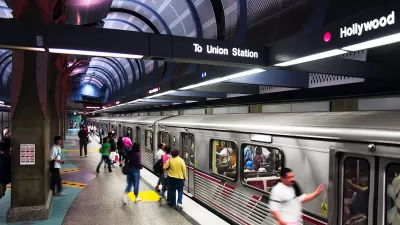Until advocates and agencies find positive stories to tell about multi-modal decision-making the car will continue to dominate the messaging and branding of contemporary culture.
"Better streets, transit lines, and bike lanes are wonderful things. But for communities hoping to kick the car habit, good marketing and public relations matter just as much as the infrastructure itself," writes Dan Malouff.
Malouff is inspired by the StreetsCamp event held last weekend. One of the event's panels focused on how marketing influences perceptions of transportation. According to Malouff, "about 100 years ago one of the most effective public-relations campaigns in the history of mankind convinced everyone that streets belong to cars, and walking is dangerous."
A century later, writes Malouff, "we're still dealing with the consequences." The article follows with several examples of advertising and messaging campaigns that make cars seem like the only viable option for mobility.
The key to changing the pitch for alternative transportation: positive, personal stories. Examples cited by Malouff include the car-free diet and Be a PAL campaigns in Arlington, Virginia.
FULL STORY: Why positive storytelling matters to transportation

Study: Maui’s Plan to Convert Vacation Rentals to Long-Term Housing Could Cause Nearly $1 Billion Economic Loss
The plan would reduce visitor accommodation by 25,% resulting in 1,900 jobs lost.

Alabama: Trump Terminates Settlements for Black Communities Harmed By Raw Sewage
Trump deemed the landmark civil rights agreement “illegal DEI and environmental justice policy.”

North Texas Transit Leaders Tout Benefits of TOD for Growing Region
At a summit focused on transit-oriented development, policymakers discussed how North Texas’ expanded light rail system can serve as a tool for economic growth.

Paris Bike Boom Leads to Steep Drop in Air Pollution
The French city’s air quality has improved dramatically in the past 20 years, coinciding with a growth in cycling.

Why Housing Costs More to Build in California Than in Texas
Hard costs like labor and materials combined with ‘soft’ costs such as permitting make building in the San Francisco Bay Area almost three times as costly as in Texas cities.

San Diego County Sees a Rise in Urban Coyotes
San Diego County experiences a rise in urban coyotes, as sightings become prevalent throughout its urban neighbourhoods and surrounding areas.
Urban Design for Planners 1: Software Tools
This six-course series explores essential urban design concepts using open source software and equips planners with the tools they need to participate fully in the urban design process.
Planning for Universal Design
Learn the tools for implementing Universal Design in planning regulations.
Smith Gee Studio
Alamo Area Metropolitan Planning Organization
City of Santa Clarita
Institute for Housing and Urban Development Studies (IHS)
City of Grandview
Harvard GSD Executive Education
Toledo-Lucas County Plan Commissions
Salt Lake City
NYU Wagner Graduate School of Public Service





























